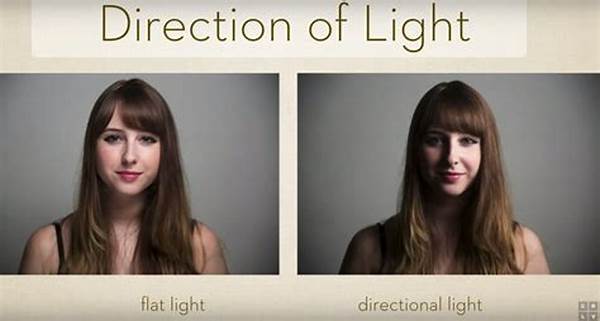Hey there, photography enthusiasts! If you’re diving into the world of portrait photography, you’ve probably realized that the game is all about lighting. Yep, that’s right—it can make or break your shot. So, what’s this buzz about directional lighting for portraits? Let’s explore the magical ways it can transform your portrait game from “meh” to “wow!”
Read Now : Methods To Improve Focus Precision
The Magic of Directional Lighting
Directional lighting for portraits is like the secret sauce that adds flavor to your shots. Imagine those stunning shadows and highlights that give life to a face. That’s what good lighting does—it sculpts and defines facial features, creating depth and dimension. It’s not just about having any light; it’s about guiding that light to work for you.
Think about it. Ever notice how professional portraits have that certain something? That’s likely the magic of directional lighting at play. It’s not just about illuminating your subject but skillfully using light to bring out their best features. You’ll be telling stories, adding drama, and setting moods all through your choice of how and where to direct that light. So next time you’re out shooting, remember: your light source is your best friend!
Being in control of directional lighting for portraits is an empowering experience. It offers you the creative freedom to highlight, dramatize, and accentuate the uniqueness of your subject’s face. Whether you’re working with natural light streaming through a window or setting up artificial lights, make them work for you. Master this, and your portraits will most definitely give off that professional, polished feel.
Tips for Mastering Directional Lighting
1. Understand Your Light Source: The first step is knowing what you’re working with. Are you using natural light or studio lights? Familiarize yourself with how each source works.
2. Experiment with Angles: Don’t be afraid to move your light around. Even slight adjustments can change the whole vibe of your photo.
3. Practice with Shadows: Light isn’t just about brightness. Shadows add incredible depth, so experiment with them to create more dynamic images with your directional lighting for portraits.
4. Use Reflectors Wisely: These are your best friend for softening shadows or bouncing light. A little reflection here and there can make all the difference.
5. Embrace Natural Light: Sometimes, the best directional lighting for portraits can come from a simple window setup. Use sheer curtains to diffuse harsh sunlight for a natural glow.
Creating Portrait Magic with Light
Think of directional lighting for portraits as your magic wand. The way light falls on your subject can change the narrative of your portrait. Play around with soft lighting for more ethereal looks or go bold with hard lighting for striking, dramatic results. Your choice of directional lighting sets the mood and tells your audience how to feel.
As you get comfortable with directional lighting, you’ll start noticing the subtle changes it can bring to your portraits. The way a shadow gracefully highlights a jawline or how a soft glow accentuates the eyes can elevate the emotional impact of your photo. It’s all about experimenting until you find that sweet spot in lighting that sings to you and your creative vision.
The beauty of learning directional lighting for portraits is that it’s a never-ending journey. As lighting conditions change, so will the techniques you use to adapt. Keep exploring, keep learning, and before you know it, your photos will carry your signature lighting style—a true testament to your creativity.
Quick Lighting Adjustments
With directional lighting for portraits, little tweaks can have big impacts:
1. Position Lighting for Drama: Angle the light from the side to sculpt features.
2. Capture Natural Indoor Flare: Catch late afternoon sunlight streaming through windows.
3. Play Around with Diffusion: Use softboxes for a mellow effect.
4. Boost with Backlighting: Give a natural halo effect around your subject.
5. Don’t Shy from Reflectors: Keep shadows in check with these handy tools.
Read Now : Biodegradable Design Packaging Options
6. Find Balance: Equalize light and shadow for a harmonious image.
7. Mind the Intensity: A simple dimmer switch can help you find the perfect balance.
8. Identify Key Light Spot: Focus on the main light source and build around it.
9. Test Shadow Patterns: Move your subject to see how shadows fall.
10. Adapt, Adapt, Adapt: Always adjust your setup to fit your subject’s unique features.
Digging Deeper into Portrait Lighting
When it comes to directional lighting for portraits, it’s not just about seeing but feeling. Imagine this: you’re trying to evoke emotion, tell a story, or go for that minimalist vibe. Light is your paintbrush, and learning to wield it can make all the difference. Sounds pretty artsy, huh? Well, it is!
Using directional lighting effectively is sort of like a dance. You and your light have to work as partners. Look for natural cues—maybe the sun is streaming in just right through the window, casting a dreamy glow on your subject’s face. All it takes is watching, waiting, and knowing when to click that shutter button. Patience and observation are key to mastering this art.
Sometimes, portrait lighting can feel intimidating—like you’re cracking open this expansive book you’ve never read before. But once you start dabbling, experimenting, and maybe even messing up a bit, you’ll become more confident in your abilities. Trust me, the payoff—a killer portrait showcasing masterful directional lighting—is well worth the effort.
Techie Breakdown of Portrait Lighting Moves
Alright, tech-lovers, let’s break this down in relatable terms. Directional lighting for portraits is like your go-to filter, adding that pop to your photos. Imagine that perfectly placed soft off-camera light that defines those angles, delivering a clean, balanced shot—it’s like fuel to your photography hustle!
Different scenarios call for different vibes. Daytime shoots with natural light? Easy—it’s about finding the balance between bright sunlight and chill shaded areas. Meanwhile, indoors under tungsten bulbs? That’s when diffusion and reflectors play their game to eliminate harshness. Just gotta keep hustlin’ and adjustin’, ya know?
There’s no one-size-fits-all in directional lighting for portraits, but once you catch the rhythm, it’s all about refining the groove. Embrace those happy accidents, unexpected light flares, or even shadows that pop up where you least expect. They all add character and life to your shots, making your portraits speak volumes.
Wrapping It Up with Style
As we cap this little journey into directional lighting for portraits, one thing stands out: exploration is key. As with any art form, it’s about finding what resonates with you, mastering it, then making it your own. And seriously, the sky’s the limit when it comes to what you can achieve with the right lighting skills.
Sure, getting the hang of it all may take some time, but hey, isn’t that part of the fun? Every click of your camera is another step toward perfecting your craft. The more you experiment with directional lighting for portraits, the more intuitive those lighting decisions will become. Your portraits will naturally start flowing with that professional polish we all aspire to achieve.
So go ahead, channel that inner lighting pro, and let your creativity shine through every portrait you capture. Whether you’re shooting a close friend or a new subject, remember, it’s not just about capturing a face, it’s about capturing the story behind those eyes. Get out there, let your light lead the way, and keep snapping those fantastic shots!



